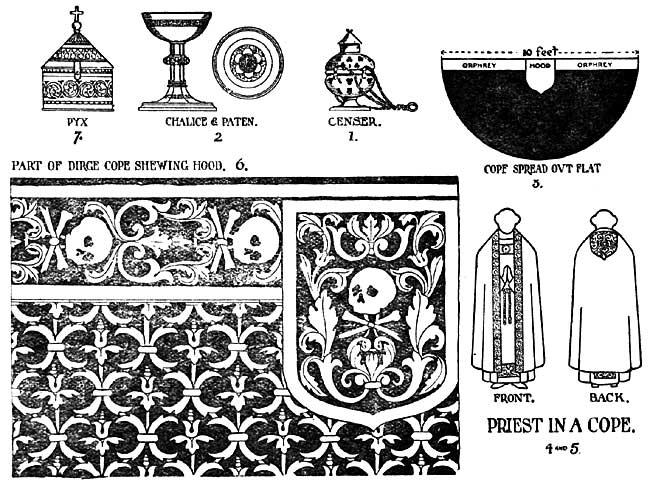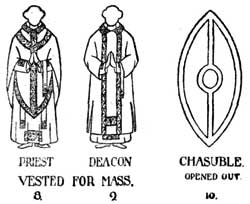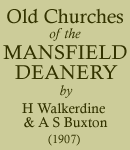< Previous | Contents | Next >
The 1552 inventory
AS an insight into the goods contained in our mediaeval churches the most valuable documents are the inventories of 1552, now kept in the Public Record Office. After the suppression of the monasteries the wave of Reformation caused the church goods to be raided, and early in Edward VI.'s reign many valuables had been locally embezzled or seized by the crown as monuments of superstition. Envious eyes were turned on the goods still left, and in 1551 it was calmly decreed that "forasmuche as the King's Majestie had neede presently of a masse of mooney, therefore commissions should be addressed into all shires of Englande to take into the King's handes such church plate as henceforth to be emploied unto His Highness' use." The commissioners however, were to leave in " every parishe churche or chappell of common resorte two or more challesis or cupps accordinge to the multitude of the people." Accordingly everything save a chalice and paten, a bell and a surplice or two, was swept into the royal coffers, and the linen distributed amongst the poor. The returns are written upon small pieces of parchment, but unfortunately, all are not extant. We give a full list of those existing in the Deanery.
Those of Mansfield and Hucknall differ from the rest in having a short introduction. Skegby is given as an example of the remainder, having only the names of the churchwardens and the inhabitants present, followed by a list of the goods. In the other inventories we have omitted the former giving merely the goods.

MANSFIELD.
"The Vth day of Septembar anno Edward j Syxty the Syxth year.
The inveytorye of the Chyrche goodes of Mansfield made by John Chambers, Wyll'm Wyld, Chyrchewardens, Wyll'm Reyvell, John Spetyllhouse, Will'm Bowlesowre, Peter Hatfyld, as foloythe. Imprimis a chalys wt a cover parsell gylte wt a pyx of cowper.
It' a sewte of vestementes of porple chamlet.
It' a sewte of vestments of grene sylke wt Towrys of Gold.
It' a grene cope wt an orfrey of whyte velvet.
It' a cope of changable sylke wt an orfrey of whyte fostyon.
It' a cope of sylke wt an orfrey of fostyon wrought wt starres.
It' a black dyrge cope of worstyd wt a grene orfrey.
It' a vestment wt brod flowrys of Crewlys wythe an Owby.
It' a vestment of dornych wt an owbe.
It' iij belles, one of them has mornyosmas bell.
It' ij Candylstyckes that stod of ye awter.
It' a peyre of sensors of cowper.
It' a hand bell wt a hale water fatt.
It' a bell wanting, sold afore the last inventoyre, and the towne
bounde to answer the value.
Bounds to answere for this bell by recognizance in xl. li. |
( Joh'es Chambers) Will'msWyld Will'ms Revel Joh'es Bolsowre ) |
de Mans-feld. |
H. Rutland, G. Pierpount, Petrus Hatfield, J. Hercy, A. Nevyll. |
||
HUCKNALL TORKARD.
"This inventory psented of the gudes of the chyrch of hucknal torkard in the county of Notyngham made the 11th day of Septembar in the syxt yere of the rean of our sofeiein lord Edward the VI. by the grace of God Kyng of England, France, and Ireland defender of the faythe and of the churches of England and Ireland, supreme head immediately under God, presented by John Lymbe and Rafe, Scorcast, chyrche wardens Richard Palmer and Bryant Lymyng.
Imprimis a chales and the paten of silver— parcell gylt.
Itm iiij vestementes one blu selke and whyte.
Itm one other of whyte selke.
Itm aother of black saye.
Itm another dorneck.
Itm one cope of black saye.
Itm ij albes.
Itm ij. auter clothes.
Itm ij candell stykes.
Itm in the stepell iij small bels.
It ij hand bells j sacring bel.
It ij cruetts of pewter.
It a crosse of latten.
SKEGBY.
"Chryst Brackhaw, Richd Wells, churchwardens.
Ralyff Innocent and the inhabyters there do psent.
Fyrst on Bell on hand bel on chales wt a covr parcell gylt.
Itm ij vestements wt ij albys the on of grene dorneck and sylke wt a
yalow cross, the other of whyte fustion wt ij auter clothes.
Itm a cross of brass.
KIRKBY-IN-ASHFIELD.
Fyrst iij belles on chales wt a paten of sylver and doble gylt.
It ij auter clothes on cope of crewle, iij vestementes ij albys ij amysses
and on to well.
Of these iij vestementes of whyt fuston another of greene crewle, and
ye thyrde of dyvers colours of crewles.
SUTTON-IN-ASHFIELD.
Imprimis on chalis wt a covr pcell gylte ij vestemente wher of on is of saten color yalow and ye other is grene and redd wythe ij albys thereto belonging.
Itm on crosse of laten wt on cope of bleue sylk.
Itm in the steple iij bells.
It j hand bel.
ij cruetts.
ANNESLEY.
Imprimis a chales of sylver pcell gylte wt a patten for ye same of sylver.
Itm two vestementes of Saye and a cope of yellow saye.
Itm one albe and syrples a table clothe for the commyon of lywyen clotlie.
Itm ijj bells in the steeple.
TEVERSAL.
Fyrst iij vestements wher of on is of dunne sylke wythe a crpsse of blue velvet.
Itm on of whyte fustion and on other of Rede crewle.
Itm a cope of grene sarsnet.
Itm a chales prcll gylte wt a covr.
Itm ij belles.
DESCRIPTIONS.

ALBE.—A long white linen gown reaching to the feet and secured by a girdle. In figure 8 of a priest vested, the alb may be seen below the chasuble.
ALTAR CLOTH.—Anciently, altars were covered with a rich tissue of precious stuff over which one linen cloth was laid during the time of celebration. Those mentioned in the Hucknall, Skegby, and Kirkby inventories would probably be the embroidered cloths for that at Annesley is specially mentioned as being of linen.
AMICE (amysse).—An oblong piece of linen with embroidery upon one of its edges resembling an ornamental collar when reposing on the shoulders. It had two strings attached to the ornamental part by which it was fastened behind the back and tied on the throat. It then covered the neck and might be drawn over the head like a hood.
CANDLESTICKS.—Probably from the altar. In England the custom seems to have been to place two candlesticks only upon the altar.
CENSER.—A sacred vessel for burning perfumes. (Fig. I.)
CHALICE.—In England the chalices were usually fine vessels from six to eight inches high, with a spreading base, and a swelling on the stem, called the knop, for convenience of handling. In 1229 the Bishop of Worcester ordered that each church was to have two chalices, one of silver to be used at mass, the other unconsecrated, and made of tin, which was buried with the priest. It is from the chalices found in the graves of ecclesiastics of priestly rank and upwards that the ancient shape is known. In most cases the solitary chalice and paten which was spared the 1552 spoliation was suffered to remain in use for a few years of Elizabeth's reign, then came a movement to substitute new cups for the old chalices. Others were melted or sold before Elizabeth came to the throne, the Puritan zeal against "mass cups" being very strong.
PATEN. — With every chalice was a paten of the same material and design, so made as to form a chalice cover. It was a small flat, shallow dish, circular in form, for the reception and distribution of the consecrated wafer.
COPE. — The most costly and magnificent of all ecclesiastical vestments. It's shape when spread out flat was an exact semi-circle (see Fig. 3), without sleeves, but furnished with a hood and fastened across the breast with a morse or clasp. The cope was worn at processions and was originally designed to protect the wearer from the inclemency of the weather. The appearance of a priest in a cope is seen in figures 4 and 5. The strips of embroidery down the front were called orphreys which were thickly ornamented with needlework, gold and jewels. Orphrey work was much esteemed and is mentioned in the Domesday Book. In Mansfield inventory a dirge cope is mentioned, part of isucli cope being shewn in Fig. 6, with the hood and part of the orphrey. To such an extent did the ornamentation of the cope go that special chests of a semi-circular shape, 10ft. across were provided in some churches so that the copes could be laid flat and thus saved damage by folding. The cope did not go out of use until after the reign of Elizabeth, for when that monarch went to St. Paul's to celebrate the country's deliverance from the Armada, "She was received by the Bishop of London, the Dean of St. Paul's, and other clergy to the number of upwards of fifty, all in rich copes, the gorgeous vestments of the church of Rome being still used on great festival occasions."
CROSS. — Probably the altar cross. Processional crosses and reliquary crosses were also used at this time and crosses pendant over altars.
CRUETS. — Small vessels of glass or metal to contain the wine and water intended for consecration at the altar. Before the Reformation, when the cup was denied the laity, the size of the altar cruets was small. Some cruets served for washing the hands of the celebrant.
"HOLY WATER FATT."— In the Mansfield inventory is doubtless a portable metal stoup, for an ordinary stone stoup would not have been mentioned, being of no value for melting purposes.
Pyx. — A small casket or vessel used for holding the consecrated wafer or the bread which had yet to be consecrated. Sometimes it took the form of a dove and was suspended over the altar.
SURPLICE.—Similar to the alb but has wider sleeves enabling it to be worn outwardly. Pugin says: "In the time of King Edward the Confessor, A.D. 1060, we read of a funeral procession with the priests vested in an alb, maniple, and stole, and olerks in surplioes with holy water."
TOWEL.—Has three significations in ancient inventories. First, a rich covering of silk and gold laid over the top of the altar, except during Mass. Secondly, linen altar cloths. Thirdly, used in the ordinary acceptance as a linen cloth for wiping the hands.
VESTMENTS—This term in old inventories often has a very wide meaning comprising the robes of the clergy, hangings of the altar, and sometimes even the sacred vessels also. Occasionally the term was applied to the chasuble alone. Figures 8 and 9 shew a priest and deacon respectively vested for mass. The priest wears a chasuble, the upper or last vestment put on by him before celebrating the mass. The form is given in Fig. 10, where a chasuble is shown spread out flat. Pugin says: "During the middle ages it hung down before and behind in long points and was gathered up in a few graceful folds over the arms." Under the ohasuble in Fig. 8 can be seen the ends of the stole, and the alb with the apparels of the sleeves and bottom. Fig. 9 shews a deacon vested in a dalmatio, which was a long robe, or upper tunic, partly open at the side. In the diagrams or both priest and deacon the maniple is shewn hanging from the left wrist.
The cloths mentioned in the inventories are:—
"CHAMLET."—Camlet, originally a tissue of goat's and camel's hair interwoven. In Elizabeth's reign the name was given to a
cloth of mixed wool and silk, first manufactured in Montgomeryshire, on the banks of the river Camlet.
"CREWLE"—Probably a groy linen elaborately embroidered.
"DORNYCK."—Dorneck, a kind of damask wrought of silk, wool, linen thread and gold. The name is derived from Dornick, the Flemish name for Tournay, in Flanders, where it was first manufactured. A coarse variety was used for carpets and hangings.
"FOSTYN"—Fustian, a twilled cotton stuff with a pile like velvet, but shorter. It came first from Fustat on the Nile.
"SARSENET"—Sarsnet, a fine thin woven silk. An improved cendal, introduced in the 15th century by the Saracens of the South of Spain.
"SAYE"—This term was used to denote a delicate kind of serge; a species of silk or satin, and also silk, velvet and worsted.
In the Mansfield inventory "towrys" means the orphreys, the "mornyosmas bell," a bell to summon the congregation to morning mass, and owby signifies alb.
Latten, mentioned in these inventories, was an alloy of brass. White latten was also used, which was a mixture of brass and tin. The term "paroell gylt " mean partly gilt, i.e., gilt on the inside.
These inventories will not give the whole of the possessions of the churches as doubtless much disappeared in the troublous times before 1552. It is very noticeable that no books are mentioned as belonging to any church in the Deanery.
